Plucked from obscurity: biographies with new and intriguing subjects | SLJ Spotlight
Looking to expand your biography collection beyond presidents and pop culture icons? These recent works highlight some lesser-known but fascinating figures who may be new to readers and educators alike. Readers will get a peek at the man behind the thesaurus, a talented athlete and gifted artist who functions without the use of his vision, a portrait of a man empowering those struggling with poverty in developing nations, and a taste of the American Revolution through a charmingly illustrated picture book about a German baker who served George Washington. We’ll also take you “Behind the Earmuffs,” for a look at the man who invented this well-worn, winter accessory. And YA fans won’t want to miss Melanie Crowder’s Audacity, a work of historical fiction that focuses on the real-life story of Clara Lemlich, a young immigrant who fought against unsafe and unjust working conditions around the turn of the 20th century.
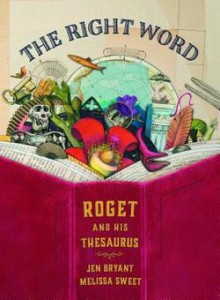
![]() Bryant, Jen. The Right Word: Roget and His Thesaurus. illus. by Melissa Sweet. 42p. bibliog. chron. further reading. Eerdmans. 2014. Tr $17.50. ISBN 9780802853851.
Bryant, Jen. The Right Word: Roget and His Thesaurus. illus. by Melissa Sweet. 42p. bibliog. chron. further reading. Eerdmans. 2014. Tr $17.50. ISBN 9780802853851.
Gr 2-5 –Those who have relied upon a thesaurus (meaning treasure house in Greek), either in print or through the tool menu of word processing software, will gain a greater appreciation for the reference tool in this beautifully designed picture book biography of its creator, Peter Roget. Bryant describes bibliophile Roget, taking him from a timid, studious child who was always compiling lists to an accomplished doctor who by 1805 had compiled the beginnings of the first thesaurus. Busy and exuberant, Sweet’s charming watercolor illustrations, layered over collages of vintage images and fonts, capture Roget’s passion for classification while also providing readers new opportunities for discovery (Latin translations of animal names, mathematical terms, and a plethora of synonyms). Expertly researched and well written, Bryant’s narrative not only details the creation of the thesaurus; it also conveys a sense of Roget the man: his shy nature, his keen intelligence, and his passion for knowledge. There truly was a particular blend of artistry and intellect that went into Roget’s book, as evidenced from a reproduced page from the original thesaurus. The book contains extensive back matter, including an incredibly detailed time line that goes into the man’s other inventions (the slide rule, the pocket chess set) and an author and illustrator’s note, as well as Roget quotations that are sure to inspire if not a love of language then at least a search for the perfect turn of phrase. An excellent illustrated biography.
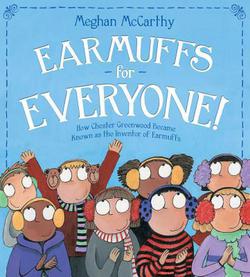
![]() McCarthy, Meghan. Earmuffs for Everyone!: How Chester Greenwood Became Known as the Inventor of Earmuffs. illus. by Meghan McCarthy. 48p. bibliog. photos. S. & S./Paula Wiseman Bks. Jan. 2015. Tr $17.99. ISBN 9781481406376; ebk. $10.99. ISBN 9781481406383.
McCarthy, Meghan. Earmuffs for Everyone!: How Chester Greenwood Became Known as the Inventor of Earmuffs. illus. by Meghan McCarthy. 48p. bibliog. photos. S. & S./Paula Wiseman Bks. Jan. 2015. Tr $17.99. ISBN 9781481406376; ebk. $10.99. ISBN 9781481406383.
K-Gr 3 –This picture book charts the evolution of the earmuff. McCarthy starts in the 18th century, discussing the ways that various inventors improved on one another’s designs, until Chester Greenwood made one last tweak to the wire headband and applied for a patent. Woven into the narrative is a description of patents. Children will also come away with a greater understanding of the nature of inventions. The book ends with a brief biography of Chester Greenwood and a section about the dedicated citizens in the state of Maine who lobbied for a Chester Greenwood Day (made official in 1977). Back matter includes an author’s note, a note about patents, and a photo of the annual Chester Greenwood Day parade in Farmington, Maine. Rendered in acrylic paint, the illustrations are appealingly cartoonlike, portraying people with exaggerated round eyes and faces, and complement the concise but upbeat text (“[Isaac Kleinert] also made dress guards, which protected ladies’ clothing from sweat. Ew!”). A solid addition for those seeking titles about inventors and inventions.
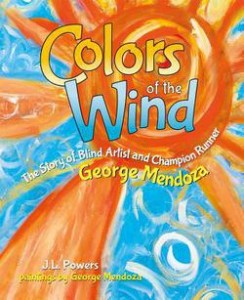 Powers, J. L. Colors of the Wind: The Story of Blind Artist and Champion Runner George Mendoza. illus. by George Mendoza & Hayley Morgan-Sanders. 48p. Purple House. 2014. Tr $18.95. ISBN 9781930900738. LC 2014001565.
Powers, J. L. Colors of the Wind: The Story of Blind Artist and Champion Runner George Mendoza. illus. by George Mendoza & Hayley Morgan-Sanders. 48p. Purple House. 2014. Tr $18.95. ISBN 9781930900738. LC 2014001565.
Gr 2-4 –This picture book tells the story of Mendoza, a blind runner who became a painter. The narrative starts off with Mendoza as an active young boy who aspired to play basketball but encountered obstacles when his vision began to fail. Instead of seeing people and objects, he saw bright and vivid colors. Mendoza channeled his energies into athletics and became a runner, attending the Olympics for the Disabled twice, and then turned his talents to painting. Morgan-Sanders’s straightforward sketches and Powers’s simple, accessible text describe Mendoza’s transition, accompanied by Mendoza’s vibrant, abstract artwork. Mendoza’s illustrations convey what the artist called his “kaleidoscope eyes” and provide testament to his considerable talent. Though additional information is included in the back matter, along with thumbnail examples of more paintings, the narrative itself is on the sparse side: the text contains no explanation for the condition that caused Mendoza’s blindness and doesn’t provide much information on how old Mendoza was when he experienced various events. Those seeking stories about contemporary artists or inspirational works about overcoming challenges will be sufficiently served by this intriguing tale.
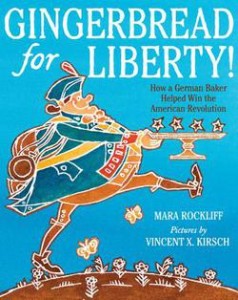
![]() Rockliff, Mara. Gingerbread for Liberty!: How a German Baker Helped Win the American Revolution. illus. by Vincent X. Kirsch. 32p. notes. Houghton Harcourt. Jan. 2015. Tr $16.99. ISBN 9780544130012.
Rockliff, Mara. Gingerbread for Liberty!: How a German Baker Helped Win the American Revolution. illus. by Vincent X. Kirsch. 32p. notes. Houghton Harcourt. Jan. 2015. Tr $16.99. ISBN 9780544130012.
Gr 1-4 –A little-known figure from the American Revolution era is given a fresh look for another generation of history lovers. This book relates the tale of a generous, beloved, and industrious member of the Philadelphia community, originally from Germany, referred to as “the baker.” The book centers on his insistence upon joining the war effort, despite being told he’s too old and fat. George Washington put the baker to work baking bread for the troops and eventually sent him on a special mission to convince the mercenary Hessian soldiers to abandon the English army. Rockliff’s dialogue-laden text is accessible, even humorous at times (“General Washington did not say the baker was old and fat. General Washington was too polite. Anyway, he had other troubles on his mind.”). Rendered in watercolor, the charming illustrations aptly depict the people and objects as gingerbreadlike, using a palette of warm, cinnamon tones and sugary white lines that detail the free-floating, cut-paper shapes. Repetitive shapes with a lack of depth complete the cookie illusion. The simple recipe on the end pages offers options for different skill levels. Back matter, including a list of sources, provides fuller detail and context as well as the baker’s name: Christopher Ludwick. A sweet addition to Revolutionary War units where a more behind-the-scenes look is desired and a nonfiction twist on gingerbread-themed storytimes.
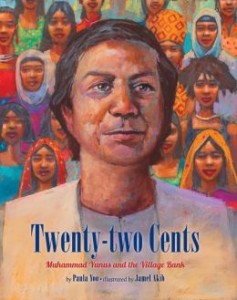 Yoo, Paula. Twenty-Two Cents: Muhammad Yunus and the Village Bank. illus. by Jamel Akib. 40p. notes. Lee & Low. 2014. RTE $18.95. ISBN 9781600606588. LC 2013041045.
Yoo, Paula. Twenty-Two Cents: Muhammad Yunus and the Village Bank. illus. by Jamel Akib. 40p. notes. Lee & Low. 2014. RTE $18.95. ISBN 9781600606588. LC 2013041045.
Gr 2-5 –This poignant picture book biography describes Muhammad Yunus, the man who developed microcredit, or the economic movement that gives small loans to the impoverished and that is breaking the cycle of rural poverty around the world.Born into a middle-class family in what is now Bangladesh in 1940, Yunus studied economics in America as a Fulbright scholar, where he saw Vietnam War protests and was “impressed by the students’ belief that they could make a difference.” Returning to Bangladesh after its brutal war for independence, Yunus was overwhelmed by resulting poverty, drought, and exploitation by moneylenders. He met a struggling craftswoman. Though she only needed 22 cents, she was denied a loan because her illiteracy and poverty made her a “banking untouchable.” In response, he founded Grameen (Village) Bank to make small loans to the poor, and the concept of microcredit was born. Honored in 2006 with a Nobel Peace Prize, Yunus accepted and in his speech celebrated “the hundreds of millions of women all around the world who struggle every day to make a living and bring hope for a better life for their children.” Yoo’s text is straightforward and detailed, and her story of a true hero of the modern world will resonate with students, while the accompanying illustrations enhance the narrative through line and color in soft chalk pastels. Back matter includes a bibliography of sources, an afterword with information about poverty in America, and an update on Yunus’s life since his retirement in 2011. This hopeful and inspiring tale sheds light on an important but little-known subject who made a huge difference.
RELATED
The job outlook in 2030: Librarians will be in demand
The job outlook in 2030: Librarians will be in demand
ALREADY A SUBSCRIBER? LOG IN
We are currently offering this content for free. Sign up now to activate your personal profile, where you can save articles for future viewing






Add Comment :-
Be the first reader to comment.
Comment Policy:
Comment should not be empty !!!